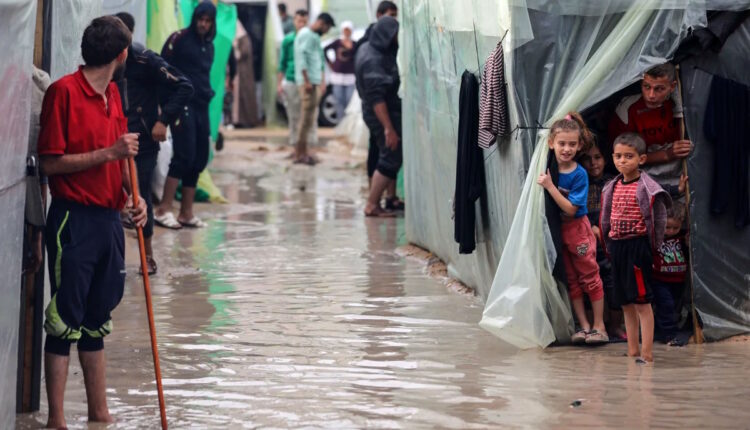A Multi-Sectoral Crisis: The Impact of Winter Weather on Internally Displaced Persons in Gaza Amidst Aid Access Restrictions
1. Introduction: A Compounded Humanitarian Catastrophe
The onset of winter precipitation and declining temperatures in the Gaza Strip is exacerbating a severe public health and humanitarian crisis for its internally displaced population. This situation is occurring within a context of extensive infrastructural destruction and a highly constrained flow of humanitarian aid, including critical shelter materials, due to ongoing access restrictions imposed by the Israeli government. This report synthesizes available data to provide a comprehensive analysis of the environmental, health, and systemic factors driving the current emergency.
2. Meteorological and Environmental Conditions
Current meteorological data for the Eastern Mediterranean region confirms a period of significantly below-average temperatures and elevated precipitation. For a displaced population residing in non-durable shelters, these conditions present a direct environmental shock. The coastal enclave’s geography, with its low-lying areas, is prone to rapid flooding, which directly compromises the integrity of makeshift settlements.
3. The Shelter and Displacement Crisis: Quantitative and Qualitative Dimensions
According to United Nations (UN) satellite imagery analysis and on-ground assessments, approximately 198,000 housing units in Gaza have been damaged or destroyed since the onset of recent hostilities. This has resulted in the internal displacement of an estimated 1.5 million individuals.
-
Shelter Typology: The displaced population is largely housed in a mix of:
-
Informal tent encampments, often constructed from wooden poles and plastic sheeting.
-
Overcrowded public buildings (e.g., schools, UNRWA facilities).
-
Damaged structures deemed unsafe for habitation.
-
-
Shelter Deficit: The UN Relief and Works Agency for Palestine Refugees (UNRWA) has stated it possesses sufficient shelter supplies—including winterized tents, sealing off kits, and thermal blankets—for approximately 1.3 million people. However, the agency reports an inability to transport these supplies into Gaza at the required scale, citing Israeli import restrictions on “dual-use” materials and procedural delays at border crossings.
4. Public Health Impacts of Exposure
The convergence of overcrowding, poor sanitation, and cold exposure creates a high-risk environment for significant morbidity and mortality.
-
Thermal Stress: Hypothermia, particularly among vulnerable groups (children, the elderly, those with pre-existing conditions), is a primary concern. Inadequate clothing and bedding directly increase susceptibility.
-
Waterborne and Respiratory Illness: Flooding contaminates water sources and creates standing water, ideal for the proliferation of waterborne pathogens (e.g., those causing cholera, dysentery). Concurrently, crowded, damp living conditions facilitate the transmission of acute respiratory infections (ARIs), influenza, and COVID-19.
-
Mental Health and Psychosocial Stress: The constant insecurity, loss of family members, and struggle for basic subsistence under these conditions contribute to widespread psychological distress, including post-traumatic stress disorder (PTSD), anxiety, and depression, a phenomenon often termed “misery on top of misery” by humanitarian officials.
5. Systemic Constraints on Humanitarian Response
The humanitarian response is systematically constrained by a complex set of access and security protocols.
-
Aid Access Blockage: Despite international calls and ceasefire agreements, the flow of humanitarian aid remains severely restricted. A limited number of trucks are cleared for entry daily, with items critical for shelter, such as reinforced tarpaulins and structural components, frequently delayed or denied entry.
-
Logistical Challenges: Within Gaza, the delivery of aid is hampered by damaged road infrastructure, fuel shortages, and persistent insecurity, including reported aerial strikes in areas near designated humanitarian zones.
6. Casualty Figures and Context
The Palestinian Ministry of Health in Gaza reports cumulative casualty figures from the conflict period. It is critical for scientific context to note that these figures are subject to verification and encompass both direct trauma casualties and indirect deaths resulting from the collapse of the health system, disease, and malnutrition. The ministry attributes these casualties to the ongoing military operations.
7. Conclusion: An Escalating Risk Scenario
The current winter conditions act as a threat multiplier, drastically increasing the vulnerability of Gaza’s displaced population. The primary driver of this crisis is not the weather itself, but the systemic inability to provide adequate shelter and protection from the elements, a direct consequence of infrastructural devastation and the blockade on essential materials. Without the immediate and unrestricted entry of shelter supplies, coupled with a robust and protected humanitarian response, a significant escalation in preventable disease and cold-related mortality is highly probable. The situation represents a clear and accelerating public health emergency requiring urgent international intervention to address the root causes of aid obstruction.
Support Dawat Media Center
If there were ever a time to join us, it is now. Every contribution, however big or small, powers our journalism and sustains our future. Support the Dawat Media Center from as little as $/€10 – it only takes a minute. If you can, please consider supporting us with a regular amount each month. Thank you
DNB Bank AC # 0530 2294668
Account for international payments: NO15 0530 2294 668
Vipps: #557320



Comments are closed.